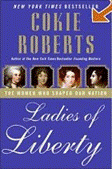
 |
Ladies of Liberty
|
Please go to the new Coffee Coaster site implemented more gracefully in Wordpress. This page: http://brianrwright.com/CoffeeCoasterBlog/?p=4288 |
 2008, Harper Collins, 402 pages
2008, Harper Collins, 402 pages
"I recall commenting in my review of John Adams that everyone had it tough back then, but the women had it grindingly tough. Our ancestors
were truly the rugged individualists of note, and Cokie Roberts has provided a starter book for further readings about the contributions to life
and liberty of the fair sex in these rugged times
at the EOC (Establishment of Country)."
Ladies of Liberty presents a lot of information about important—by which I mean central to American political or cultural history—women in the early years of the country. As we learn from reading John Adams, the success of the American experiment was far from assured; indeed, the constitutional republic of America represented a near-miraculous shift in human consciousness: Prior to its founding, men saw themselves as subjects of rulers; afterward, men saw themselves as rulers of rulers. And Cokie Roberts reminds us, "So did the women."
No question the world of the time of the War for Independence was patriarchal: women could not vote and in most states they could not own property or perform several of the contractual behaviors that are taken for granted today. Heck, even into the middle of the 20th century, women were legally suppressed in the "independence" department and socially diminished in the cultural department: As I grew up through the 1950s, we were more-or-less indoctrinated through the centralized corporate-government system to view women as childbearers, childrearers, and homemakers whose fundamental psychobiological purpose was to 'stand by their men.'
When you think of that way of life, it sounds awfully similar to what I have been reading in John Adams when Jefferson and others describe the noxiousness of the institution of slavery. It's a toxic blotch on everyone, and it encourages a feeling of superiority in subhuman mentalities on the basis of no virtue whatever... tailor made for moral laziness on all sides. Fortunately, the seeds of liberty in America contained everything needed to bring forth the full flowering of women's equality of rights through the next two centuries.
Naturally, these seeds of women's liberation were, in fact, the passionate, intelligent, issue-focused women that Cokie Roberts presents to us. The book is a little confusing in its intentions; I had expected these ladies that Ms. Roberts documents to be solely five of the first first ladies of the United States (or in the case of Thomas Jefferson, key women of his family). And the chapter headings identify these rather well-known women: Abigail Adams, Elizabeth Patterson Bonaparte, Dolley Madison, Rosalie Stier Calvert, and Elizabeth Monroe.
Roberts does spend a good deal of her conversation telling us what important roles these women
played. [I particularly appreciate the writing of Abigail Adams, which Cokie's book serves to remind me of from my reading of John Adams.] But, in my humble opinion, the sadly-and-essentially unpromoted characteristic of Ladies of Liberty is its most important quality: its descriptions of several great 'ordinary' women of the early post-colonial period—some of whom achieved little notoriety and few of whom hobnobbed with big pols:
In Philadelphia, Susanna Rowson, as the playwright of dramas and musical comedies, became an instant hit with the city's political and social elites. Soon she published an American edition of her English
novel with the title Charlotte Temple, which reigned as the bestselling book in this country until Harriet Beecher Stowe wrote Uncle Tom's Cabin... — page 55
As the 18th century closed, the rapid spread of publishing was making it possible for women to present questions about their rights before a wide audience. More publishing meant not only more bookstores but the birth of lending libraries—making books, newspapers, and, especially, magazines available to all comers.... And magazines designed explicitly for women, with articles often written by women, started filling the stacks in the 1790s. (The first American cookbook was also published. In 1796, American Cookery, by Amelia Simmons, An American Orphan, finally provided US cooks with recipes using New World ingredients like cornmeal. The word "cookie," taken from the Dutch koekje, appeared for the first time in Amelia Simmons' book.) ...[18th century women's magazines] featured fiction, poems, and advice on such subjects as how to have a happy marriage, but they also served as platforms for (and against) women's rights. — page 59
Roberts then goes on to describe the work of the courageous feminist Judith Sargent Murray who wrote as Constantia and questioned "whether anyone thought a two-year-old boy smarter than a two-year-old girl." Murray made the case that it was lack of education, rather than lack of intellect, holding women back. Some further 'lesser knowns' discussed:
If they were to make it all the way west, Lewis and Clark would need to convince the Shoshones, who lived at the Missouri River's headwaters, to sell some horses from their famous herds. A Shoshone speaker could greatly enhance their chances of success, so the captains signed [French Canadian trader] Toussaint Charbonneau and his Shoshone wife, Sacagawea, up for the journey. [It's generally acknowledged that without the help of Sacagawea, the L&C expedition would have failed.] — page 124
Like Thomas Jefferson with his daughter Martha, Aaron Burr paid close attention to his little girl's [Theodosia's] education, outlining a rigorous course of study for her to follow. But unlike
Jefferson, Burr had no hesitation about educating a girl in what were considered masculine subjects; in fact, he was inspired to treat the sexes equally by Mary Wollstonecraft's radical Vindication of the Rights of Women, first published in 1792. — page 145
While Theodosia [Burr] Alston fed her father's fantasies of building an empire, the other woman whose life was upended by Aaron Burr was busy establishing something real and lasting—an institution for poor children of New York. In 1806, Alexander Hamilton's widow helped the still socially active Isabella Graham found the Orphan Asylum Society of New York, designed to serve the growing number of children left homeless in the ever-expanding commercial city. — page 161
There are several other women, widely unknown and unappreciated through history, and Roberts breathes new life into them. One more example: this one a personal favorite:
[Facts suggesting massive migration westward] give no sense of what this westward movement was like for the people who had the courage and pluck to settle the still primitive territory. With no means of transportation over land other than wagon, horse, or foot, just getting there signified triumph. To facilitate the western settlements, Congress had authorized the building of what came to be called the National Road from Cumberland, Maryland, to Wheeling in what's now West Virginia in 1806, but construction didn't start for five years; and though regular steamship service on the Hudson River following the 1807 maiden voyage of the Clermont, soon joined by the Phoenix on the Delaware, was highly beneficial to travelers on those waterways, the steamships didn't help the settlers headed west until the Erie Canal opened in 1825. Still, thousands of intrepid souls braved the journey across the mountains to seek their fates, or find their mates. Happily for us, some of those pioneers kept journals. One was Margaret Van Horn Dwight, who in 1810 at the age of 19 made the six-week wagon ride from New Haven, Connecticut, to Warren, Ohio. — page 210
The same journey today, would require ~one workday.
Every one of these stories of
the women we know primarily as presidents' wives and, especially, these less politically connected women we know far less about, is fascinating. And Cokie is a fine writer, with a conversational, humane tone.
I recall commenting in my review of John Adams that everyone had it tough back then, but the women had it grindingly tough. Our ancestors were truly the rugged individualists of note, and Cokie Roberts has provided a starter book for further readings about the contributions to life and liberty of the fair sex in these rugged times at the EOC (Establishment of Country). I'm particularly enthralled with Susanna Rowson, Judith Sargent Murray, and Margaret Van Horn Dwight. [By the way, I'd like to suggest exploration of particularly libertarian/individualist feminist writers of the 19th century, and I do so by reference to a book by Wendy McElroy of that name.]
A fine mainstream effort by a good journalist with heart.
Everyone will learn a great deal from this work.
###
###

 Click banner to order, click here for book review
Click banner to order, click here for book review
 Click banner to order, click here for book review
Click banner to order, click here for book review
 |
 |
|||
| New Pilgrim Chronicles Forum |